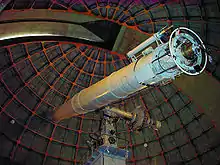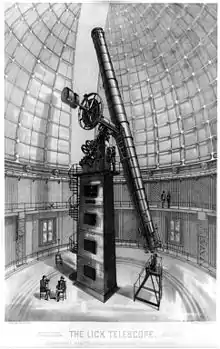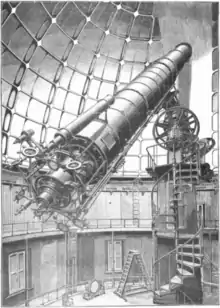James Lick telescope
The James Lick Telescope is a refracting telescope built in 1888. It has a lens 36 inches (91 cm) in diameter- a major achievement in its day. The instrument remains in operation and public viewing is allowed on a limited basis. Also called the "Great Lick Refractor" or simply "Lick Refractor", it was the largest refracting telescope in the world until 1897 and now ranks third, after the 40-inch refractor at the Yerkes Observatory and the Swedish 1-m Solar Telescope. The telescope is located at the University of California's Lick Observatory atop Mount Hamilton at an elevation of 4,209 feet (1,283 m) above sea level. The instrument is housed inside a dome that is powered by hydraulic systems that raise and lower the floor, rotate the dome and drive the clock mechanism to track the Earth's rotation. The original hydraulic arrangement still operates today, with the exception that the original wind-powered pumps that once filled the reservoirs have been replaced with electric pumps. James Lick is entombed below the floor of the observing room of the telescope.
 The James Lick telescope | |
| Named after | James Lick |
|---|---|
| Part of | Lick Observatory |
| Location(s) | Lick Observatory Main Building, Santa Clara County, California |
| Coordinates | 37°20′28″N 121°38′35″W |
| Organization | University of California |
| Altitude | 4,200 ft (1,300 m) |
| Built | 1880–1888 |
| First light | 3 January 1888 |
| Telescope style | optical telescope refracting telescope |
| Diameter | 36 in (0.91 m) |
| Length | 57 ft (17 m) |
| Mass | 25,000 lb (11,000 kg) |
| Focal length | 17.37 m (57 ft 0 in) |
| Mounting | equatorial mount |
| Enclosure | dome |
| Website | www |
 Location of James Lick telescope | |

Here are some excerpts from an 1894 book describing the telescope:[1]
- The height of the marble floor of the main building above mean sea level is 4209 feet. On a closely connected peak half a mile to the east of the Observatory, and 50 feet higher, are the reservoirs from which water for household and photographic purposes is distributed. A spring about 350 feet below and one mile to the northeast of the Observatory supplies excellent water. Another peak seven-eighths of a mile to the east is the summit of Mount Hamilton; it is 180 feet higher than the Observatory, and supports the reservoirs supplying power for moving the dome, raising the movable floor, and winding the driving clock of the great telescope. This system receives its supply from the winter rains falling on the roofs; the water being pumped to the reservoirs on the higher peak by means of windmills.
- The movable floor in the dome is the first of the kind to be constructed. It is 60 feet (18 m) in diameter, and can be raised or lowered through a distance of 16 1⁄2 feet (5.0 m), its purpose being to bring the observer within convenient reach of the eye end of the telescope.
Construction

The fabrication of the two-element achromatic objective lens, the largest lens ever made at the time, caused years of delay.[2] The famous large telescope maker Alvan Clark was in charge of the optical design. He gave the contract for casting the high quality optical glass blanks, of a size never before attempted, to the firm of Charles Feil in Paris. One of the huge glass disks broke during shipping, and making a replacement was delayed. Finally, after 18 failed attempts, the lens was finished, transported safely across country, and on December 31, 1887, was carefully installed in the telescope tube. The builders had to wait for three days for a break in the clouds to test it. On the evening of January 3 the telescope saw first light,[2] and users found that the instrument couldn't be focused. An error in the estimation of the lens' focal length had caused the tube to be built too long. A hacksaw was procured, the great tube was unceremoniously cut back to the proper length and the star Aldebaran came into focus.
Contemporaries on debut
Legend
(100 cm equals 1 meter)
| Name/Observatory | Aperture cm (in) |
Type | Location then (Original Site) | Extant* |
|---|---|---|---|---|
| Yerkes Observatory[3] | 102 cm (40″) | achromat | Williams Bay, Wisconsin, USA | 1897 |
| National Observatory, Paris | 122 cm (48″) | reflector | Paris, France | 1875–1943[4] |
| James Lick telescope, Lick Observatory | 91 cm (36″) | achromat | Mount Hamilton, California, USA | 1888 |
| Crossley Reflector[5] | 91.4 cm(36″) | reflector – glass | Lick Observatory, USA | 1896 |
References
- A Brief Account of the Lick Observatory of the University of California. The University Press, 1894.
- Misch, Tony; Remington Stone (1998). "The Building of Lick Observatory". Lick Observatory website. Univ. of California. Retrieved 2008-06-30. External link in
|work=(help) - "Archived copy". Archived from the original on 2009-02-25. Retrieved 2019-10-02.CS1 maint: archived copy as title (link)
- "1914Obs....37..245H Page 250". Retrieved September 8, 2019.
- "Mt. Hamilton Telescopes: CrossleyTelescope". ucolick.org. Retrieved September 8, 2019.
External links
 Media related to James Lick telescope at Wikimedia Commons
Media related to James Lick telescope at Wikimedia Commons- Photographs of the James Lick telescope from the Lick Observatory Records Digital Archive, UC Santa Cruz Library's Digital Collections